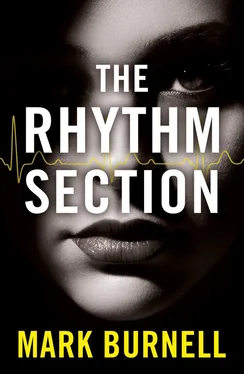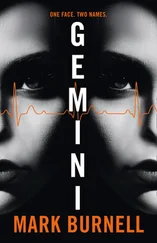He said, ‘I hope you don’t feel as ill as you look.’
The muscles in her stomach were trembling. ‘I thought it was some kind of hangover …’
‘Sit down. I’ll get you some water.’
‘I’ll be fine in a minute.’
‘I’m not so sure about that.’ When Proctor returned with a glass in hand, Stephanie had put on her coat and was fetching her rucksack. ‘What are you doing?’
‘I’ve got to go.’
‘Why?’
‘That’s none of your bloody business.’
‘Look, you don’t have anywhere to go to.’
She looked insulted, then defiant. ‘I can’t stay here.’
‘Why not?’
Her eyes said it first. ‘Because I don’t trust you.’
‘Well, I don’t trust you, either. But I’m willing to take that risk.’
‘Then you’re an idiot. If you knew what I know, you wouldn’t say that so easily.’
‘I’m sure you’re right but if I was going to harm you, I’d have probably done it by now. You can leave if you want to. I won’t stand in your way. But if you want to stay here, you can.’
It was a savagestrain of influenza that laid Stephanie low. Proctor offered her his bed but she refused, preferring the sofa. He made her soup, brought her tea, fed her aspirin. She was sullen and silent. For four days, she did little more than sleep. Her temperature fluctuated wildly and during the first forty-eight hours, she vomited repeatedly. The aches never ceased. It was like narcotic withdrawal, the destructive drug being Stephanie herself, her body rejecting every aspect of her poisonous life. At one point, Proctor considered consulting a doctor but Stephanie was adamant that he shouldn’t. When she awoke on the fifth morning, she knew she was getting better.
Proctor was making coffee. Not instant coffee, but real coffee. Stephanie enjoyed watching the little rituals of preparation, from the grinding of the beans to the cup. She noticed that Proctor was a man who enjoyed practical precision. She saw it in the way he kept everything so clean, in the order that ruled his flat and his appearance. There was no chaos around him and, she suspected, none inside him, either.
They returned to the living room. On the cherry table there were two bulging files, a folder, which was open, and an enlarged colour photograph of a Boeing 747. The fuselage and the engines were deep blue. Running forward of the wing’s leading edge were three enormous, crimson letters: NEA. North Eastern Airlines. The letters reached from the belly to the upper deck, and almost as far forward as the flight deck. On the tail, there was a white circle with two arrows pointing out from the centre, one heading north, the other heading east.
Proctor saw Stephanie looking at the photograph and said, ‘Flying in a pressurized aircraft at altitude is like flying in an aerosol can. Now if you imagine –’
‘I don’t want to imagine anything. Just tell me what happened.’
Proctor flicked through one of the files and unclipped a sheet of paper from it, which he then spread across the table-top. It was a diagram of a 747, seen from the front, from both sides and from above, this view including the lay-out of the seating. The North Eastern logo was in the bottom right-hand corner.
‘There were two explosions. The first one – the smaller of the two – occurred at an altitude of thirty-seven thousand feet. It blew a hole in the fuselage just in front of the wings, here –’ He pointed at one of the side views. ‘– and, less destructively, at the same point on the other side. Critically, the force of the blast was not powerful enough to tear the aircraft in two. As soon as it happened, the 747 fell into a steep descent while the flight crew tried to regain control. They were experienced enough – they had over forty-five thousand hours of accumulated flying time between them – but in this situation, there wasn’t much they could do.
‘At this point, it’s probable that most of the casualties were behind the blast. Those in the nose and on the upper deck – first and business class, mainly – would have been less likely to suffer the worst of the deceleration injuries, although they’d still have been damaged by them. In the end, of course, it made no difference. At twelve thousand feet, there was a second explosion and this was what tore the aircraft in two. Or rather, into pieces.’
Proctor poured some coffee into a pale lilac cup which was sitting on a saucer. Stephanie lit her first cigarette in almost a week, then took the cup and saucer and returned her attention to the diagram between them. ‘So what was all that stuff about electric wiring?’
‘The official verdict was inconclusive. The eventual findings dealt only in probability and theory, one of which suggested that a section of electrical wiring may have been faulty. There are lawsuits pending against both Boeing and North Eastern Airlines but while the cause remains only “probable” they are unlikely to be found culpable. If there was more conclusive proof that the cause was something mechanical or negligent, you can be sure that both Boeing and NEA would be investigating the matter more thoroughly, looking for ways out. With this verdict, they’re as happy as they can be in an unhappy situation. It’s no coincidence that pilot error is so frequently the cause of a crash; when the accused is dead, he can’t provide awkward answers to tricky questions. Pilot error is a lot cheaper than structural, mechanical or procedural failure.’
‘But there must be investigators who know the truth. What about the ones who discovered the evidence?’
‘Normally, when there’s a tragedy of this nature, there are investigators all over it. FBI, FAA, members of the NTSB – the American National Transportation Safety Board – to name but a few. They swarm all over the debris and all over the dead. In this case, however, the crash site was in the middle of the Atlantic. That severely reduced the number of agents who could physically get there. What’s more, the FBI reduced the number yet further by vetting those allowed to make the trip.’
‘I wasn’t aware the mid-Atlantic was part of their jurisdiction.’
‘It isn’t. But ultimately the ships and planes involved were, since the FBI was heading the investigation. Which is how they came to have the final say. They were very careful – and influential – about which FAA agents and, more specifically, which representatives from the NTSB were allowed out to the crash site. The same security applied to the testing conducted on recovered debris and human remains when they were returned to the United States.’
‘What are you saying?’
‘According to my source at MI5, the FBI received two warnings that a terrorist attack was on the cards. The first was about six months before, the second was just three weeks before. In their wisdom, they decided not to pass the warnings on to the airlines.’
‘Why not?’
‘I don’t know. They’d probably say that they get a lot of dud information – and a lot of hoaxes, too – and that they have to make a tough call each time. Perhaps they weren’t convinced of the sincerity or legitimacy of the warnings.’
In one of the two files that were on the table, Proctor had stored all the relevant articles he could find. They ranged from newspaper and magazine reports published in the immediate aftermath of the crash to coverage of the investigations executed by the FAA, the FBI and the NTSB. The initial assumption had been that flight NE027 had been brought down by a terrorist bomb. In the first forty-eight hours, all the usual suspects were accused; Arab terrorist organizations, Colombian drug cartels, home-grown fanatics from the mid-western militias. But during the months that followed, each potential villain was removed from the equation. Cocooned by her decline, Stephanie had still retained enough awareness of the outer world to recall the glacial progress towards a verdict that favoured structural or mechanical failure, ‘favoured’ being as close as it ever got.
Читать дальше












